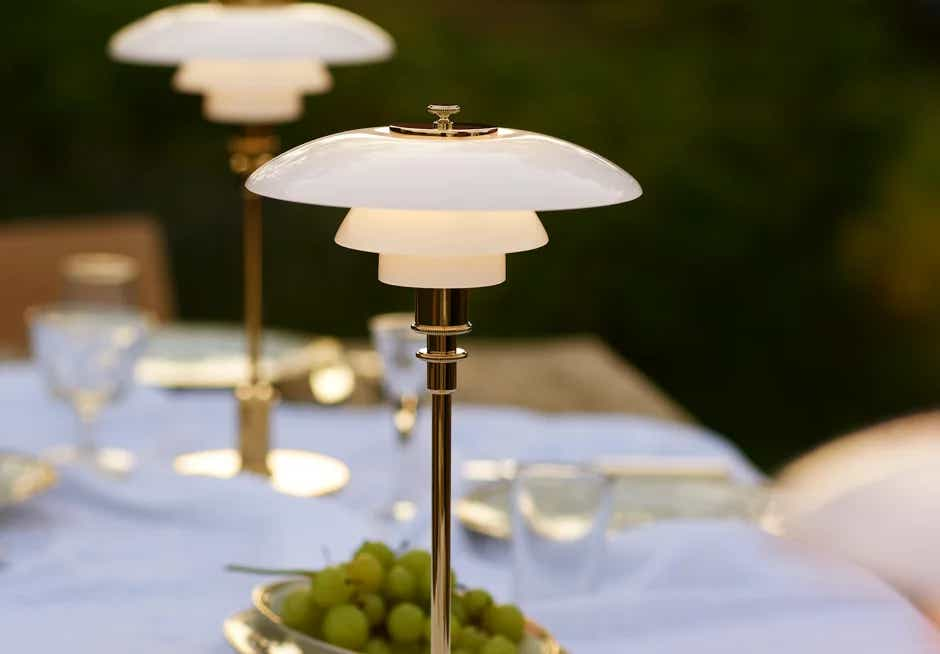
Cordless lamps represent a revolution in the world of lighting, and leading brands of designer luminaires offer many of them.
In the constantly evolving world of lighting, wireless lamps, equipped with rechargeable batteries and highly efficient lighting technologies, have emerged as an innovative solution that combines flexibility with design. These portable and autonomous lamps have transformed our approach to illuminating spaces, offering unprecedented freedom in creating lighting atmospheres.
At the heart of every battery-powered lamp lies a rechargeable energy source, typically a lithium-ion battery. These batteries offer varying autonomy, ranging from a few hours to several days of continuous use, depending on the model. Most portable lamps utilize LED (Light Emitting Diode) technology, known for its low energy consumption and longevity.
The recharging process varies depending on the model. Some portable lamps are equipped with USB ports for easy recharging, while others use dedicated charging stations or induction charging systems. Recharge times can vary significantly, from a few hours to an entire night, depending on the battery capacity and the power of the charger.
Mobility: The absence of a cable allows the lamp to be moved freely, offering unparalleled flexibility in space arrangement.
Versatility: These battery-powered lamps adapt to various environments, from indoors to outdoors, meeting a multitude of lighting needs.
Safety: The elimination of cables reduces the risk of tripping, a particularly appreciated advantage in high-traffic areas or in the presence of children.
Aesthetics: The lack of wires allows for a sleeker design and more harmonious integration into the decor.
Energy Savings: The use of LEDs and the possibility of recharging via renewable energy sources make them an ecological option.
Ease of Installation: There’s no need to worry about the proximity of an electrical outlet or complex installation work.
The market for wireless lamps is vast, offering a diversity of models that meet various needs.
There are ambiance lamps, which emit a soft and warm light, perfect for creating a relaxing atmosphere in a living room or bedroom. These lamps are often equipped with dimmers, allowing the light to be adjusted according to the mood or activity.
Portable lamps, on the other hand, are particularly appreciated for their practicality. Compact and lightweight, they are easily transportable and often come with a handle or hook to be hung where needed. They are perfect for illuminating specific areas, such as a workshop, garage, or tent during outdoor trips.
When choosing a portable lamp, it is important to first consider the materials used. There is a wide variety of options, each with its own characteristics in terms of aesthetics and durability. Wood, metal, glass, and composite materials are commonly used, each adding a distinct touch to the final design. The finishes are also very varied, ranging from brushed metal to varnished wood, to matte or glossy surfaces, catering to all tastes and interior styles.
On the technological side, battery-powered lamps often incorporate LED bulbs, which are very energy efficient and offer a long lifespan. The bulbs can be easily replaced at the end of their life.
Integrated LED circuits, on the other hand, allow for great flexibility in terms of design, as they are very compact and can be integrated into very thin and lightweight structures. Additionally, LED circuits allow for color temperature adjustment, ranging from cool light for better concentration to warm light for a more convivial atmosphere.
Rechargeable batteries are another crucial element of wireless lamps. Advances in this field have led to the development of lighter, smaller, and above all, more efficient batteries. They now offer sufficient autonomy for prolonged use while recharging quickly. Some lamps use lithium-ion batteries, similar to those found in smartphones and other electronic devices, which ensure a long lifespan and efficient recharging.
In addition to their practical aspect, portable lamps have a significant ecological interest. Indeed, the use of rechargeable batteries and LED technologies reduces energy consumption compared to traditional lighting systems. LEDs consume up to 80% less energy than conventional incandescent bulbs, resulting in a reduced carbon footprint associated with their use.
Moreover, the possibility of recharging lamps via renewable energy sources, such as solar panels, reinforces their ecological aspect. Some portable lamps are even specifically designed to be used in conjunction with solar charging devices, making them even more autonomous and environmentally friendly.
We believe that three technical criteria should be prioritized when choosing:
Autonomy: The operating time on a single charge is a crucial factor, especially for intensive or outdoor use.
Luminous Power: Measured in lumens, it determines the intensity of the lighting. Choose according to your specific needs.
Color Temperature: Expressed in Kelvin, it influences the ambiance. Warm light (2700-3000K) is more relaxing, while cooler light (above 3000K) is more illuminating.
Cordless lamps, whether they're called battery-powered, portable or hand-held, have become an essential part of contemporary lighting design. Combining practicality, flexibility and aesthetic appeal, they can be adapted to a multitude of situations and environments, offering unprecedented freedom of use. Scandinavian brands, with their sense of pure, functional design, have played a major role in the development of these products.